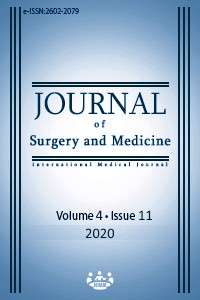Trial of hirudotherapy in labial necrosis: A case report
Keywords:
Hirudotherapy, necrosis, labiaplasty, postoperative care, Leech therapyAbstract
Treatment of a patient who developed post-operative labial necrosis was aimed with hirudotherapy. A Bartholin cyst was excised but because of the size of the cyst, labial asymmetry occurred, therefore, labial reconstruction was performed on the left labium majus. On post-operative Day 2, the labia became ischemic and necrosis began to develop. We applied hirudotherapy, but no difference was observed after the 5th day. Part of necrotic labium spontaneously split from the healthy tissue underneath. Leech therapy has been used for a long time; however, it was approved by FDA in 2004 and it is a very rarely used treatment method in gynecology. There are no guidelines on duration of leech application, and we wanted our case to set an example. In our case, we eventually had to excise the necrotic labium, which may be due to delay or the insufficient length of leech therapy.
Downloads
References
Whitaker IS, Rao J, Izadi D, Butler PE. Historical Article: Hirudo medicinalis: ancient origins of, and trends in the use of medicinal leeches throughout history. Br J Oral Maxillofac Surg. 2004;42(2):133-7.
Mory RN, Mindell D, Bloom DA. The leech and the physician: biology, etymology, and medical practice with Hirudinea medicinalis. World J Surg. 2000;24(7):878-83.
Herlin C, Bertheuil N, Bekara F, Boissiere F, Sinna R, Chaput B. Leech therapy in flap salvage: Systematic review and practical recommendations. Ann Chir Plast Esthet. 2017;62(2):1-13.
Ahmed T, Anwar M. Clinical importance of leech therapy. Indian Journal of Traditional knowledge. 2009;8(3):443-5.
Srivastava A, Sharma R. A brief review on applications of leech therapy. Arch Apll Sci Res. 2010;2(2):271-4.
Abdualkader AM, Ghawi AM, Alaama M, Awang M, Merzouk A. Characterization and optimization of lyophilization and storage conditions of Leech saliva extract from the tropical leech Hirudinaria manillensis. Pak J Pharm Sci. 2013;26(3):525-3.
Haycox CL, Odland PB, Coltrera MD, Raagi GJ. Indications and complications of medicinal leech therapy. J Am Acad Dermatol. 1995;33(6):1053-5.
Abdullah S, Dar LM, Rashid A, Tewari A. Hirudotherapy/leech therapy: applications and indications in surgery. Arch Clin Exp Surg. 2012;1:172–80.
Das BK. An overview on hirudotherapy/leech therapy. Ind Res J Pharm Sci. 2014;1:33–45.
Hildebrandt JP. Lemke S. Small bite, large impact–saliva and salivary molecules in the medicinal leech, Hirudo medicinalis. Naturwissenschaften. 2011;98:995–1008. [PubMed]
Singh A.P. Medicinal leech therapy (hirudotherapy): a brief overview. Complement Ther Clin Pract. 2010;16:213–5.
Whitaker IS, Oboumarzouk O, Rozen WM, et al. The efficacy of medicinal leeches in plastic and reconstructive surgery: a systematic review of 277 reported clinical cases. Microsurgery. 2012;32:240-50.
Karadag AS, Calka O, Akdeniz N, Cecen I. A case of irritant contact dermatitis with leech. Cutan Ocul Toxicol. 2011;30:234–5.
Kunal J, Aarti G, Ridhi N, Sunanda D. Hirudotherapy in Medicine and Dentistry J Clin Diagn Res. 2015 Dec;9(12):ZE05–7.
Downloads
- 499 1012
Published
Issue
Section
How to Cite
License
Copyright (c) 2020 Ozan Doğan, Ulaş Çoban, Işıl Ayhan, Ali Kasapoğlu, Eray Çalışkan
This work is licensed under a Creative Commons Attribution-NonCommercial-NoDerivatives 4.0 International License.
















